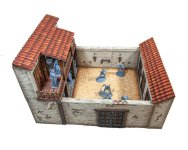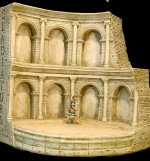- Joined
- Feb 2, 2011
- Messages
- 2,253
JJDESIGNS NEWS UPDATE 30th JUNE 2025
GLADIATORS
"HAIL, EMPEROR, THOSE WHO ARE ABOUT TO DIE SALUTE YOU."
Gladiators were armed combatants who entertained audiences in the Roman Republic and Roman Empire in violent confrontations with other gladiators, wild animals and condemned criminals.
Some gladiators were volunteers who risked their lives and their legal and social standing by appearing in the arena, but most were despised as slaves, schooled under harsh conditions, socially marginalized and even segregated even in death.
Irrespective of their origin, gladiators offered spectators an example of Rome’s martial ethics and in fighting or dying well, they could inspire admiration and popular acclaim.
They were celebrated in high and low art, and their value as entertainers was commemorated in precious and commonplace objects throughout the Roman world.

The earliest types of gladiator were named after Rome’s enemies of that time, such as the Samnites, Thracians and Gauls.
Initially each type seems to have fought against a similar or identical type, but later various different types of gladiators were introduced, and dissimilar but complimentary types were paired against each other.
One of the most common was the bare headed lightly armoured, nimble “Retiarius” (net-man), who was armoured only at the left arm and shoulder, with his net, trident and dagger would be pitted against the more heavily armoured, helmeted secutor.

Trained gladiators were expected to observe professional rules of combat. Most matches employed a senior referee (Summa Rudis) and an assistant, shown in mosaics with long staffs (rudes) to caution or separate opponents at some crucial point in the match. Referees were usually retired gladiators whose decisions, judgement and discretion were for the most part respected. They could stop bouts entirely or pause them to allow the combatants rest, refreshmnet and a rub down.

A match was won by the gladiator who overcame his opponent, or killed him outright.
Victors received the palm branch and an award from the editor.
An outstanding fighter might receive a laurel crown and money from an appreciative crowd but for anyone originally condemnedad ludum, the greatest reward was manumission (release from slavery) symbolised by the gift of a wooden training sword or staff (rudis) from the editor.

A gladiator could acknowledge defeat by raising a finger (ad digitum), in appeal to the referee to stop the combat and refer to the editor, whose decision would usually rest on the crowds response.
In the earliest contests, death was considered a righteous penalty for defeat, but later those who fought well might be granted remission at the whim of the crowd or the editor.
During the Imperial era, matches advertised as sine missione (understood to mean “without reprieve” for the defeated) suggests that the sparing of a defeated gladiator’s life had become common practice.

By common custom, the spectators decided whether or not a losing gladiator should be spared, and chose the winner in the rare event of a standing tie.
The final decision of death or life belonged to the editor, who signalled his choice with a gesture described by Roman sources as “police verso” meaning “with a turned thumb”, which is a description too imprecise for reconstruction of the gesture or its symbolism.
Whether victorious or defeated a gladiator was bound by oath to accept or implement his editor’s decision.

An official would be dressed in a mask of Charon, to represent the ferryman of the dead, and would strike a corpse with a mallet.
This was normally reserved for the Noxii or criminals condemned to death, but gladiator skulls found in a gladiator cemetery, and by modern pathological examination has also confirmed the probable fatal use of a mallet on some.
It has been suggested that gladiators who disgraced themselves might have been subjected to the same indignities as noxii, and denied the relative mercies of a quick death, and therefore would have been dragged from the arena as carrion.

Gladiator games lasted for nearly a thousand years, reaching their peak between the 1st century BC and the 2nd century AD.
The first of the Gladiator sets will be available with the August 2025 releases.
Best wishes,
john jenkins
GLADIATORS
"HAIL, EMPEROR, THOSE WHO ARE ABOUT TO DIE SALUTE YOU."
Gladiators were armed combatants who entertained audiences in the Roman Republic and Roman Empire in violent confrontations with other gladiators, wild animals and condemned criminals.
Some gladiators were volunteers who risked their lives and their legal and social standing by appearing in the arena, but most were despised as slaves, schooled under harsh conditions, socially marginalized and even segregated even in death.
Irrespective of their origin, gladiators offered spectators an example of Rome’s martial ethics and in fighting or dying well, they could inspire admiration and popular acclaim.
They were celebrated in high and low art, and their value as entertainers was commemorated in precious and commonplace objects throughout the Roman world.

The earliest types of gladiator were named after Rome’s enemies of that time, such as the Samnites, Thracians and Gauls.
Initially each type seems to have fought against a similar or identical type, but later various different types of gladiators were introduced, and dissimilar but complimentary types were paired against each other.
One of the most common was the bare headed lightly armoured, nimble “Retiarius” (net-man), who was armoured only at the left arm and shoulder, with his net, trident and dagger would be pitted against the more heavily armoured, helmeted secutor.

Trained gladiators were expected to observe professional rules of combat. Most matches employed a senior referee (Summa Rudis) and an assistant, shown in mosaics with long staffs (rudes) to caution or separate opponents at some crucial point in the match. Referees were usually retired gladiators whose decisions, judgement and discretion were for the most part respected. They could stop bouts entirely or pause them to allow the combatants rest, refreshmnet and a rub down.

A match was won by the gladiator who overcame his opponent, or killed him outright.
Victors received the palm branch and an award from the editor.
An outstanding fighter might receive a laurel crown and money from an appreciative crowd but for anyone originally condemnedad ludum, the greatest reward was manumission (release from slavery) symbolised by the gift of a wooden training sword or staff (rudis) from the editor.

A gladiator could acknowledge defeat by raising a finger (ad digitum), in appeal to the referee to stop the combat and refer to the editor, whose decision would usually rest on the crowds response.
In the earliest contests, death was considered a righteous penalty for defeat, but later those who fought well might be granted remission at the whim of the crowd or the editor.
During the Imperial era, matches advertised as sine missione (understood to mean “without reprieve” for the defeated) suggests that the sparing of a defeated gladiator’s life had become common practice.

By common custom, the spectators decided whether or not a losing gladiator should be spared, and chose the winner in the rare event of a standing tie.
The final decision of death or life belonged to the editor, who signalled his choice with a gesture described by Roman sources as “police verso” meaning “with a turned thumb”, which is a description too imprecise for reconstruction of the gesture or its symbolism.
Whether victorious or defeated a gladiator was bound by oath to accept or implement his editor’s decision.

An official would be dressed in a mask of Charon, to represent the ferryman of the dead, and would strike a corpse with a mallet.
This was normally reserved for the Noxii or criminals condemned to death, but gladiator skulls found in a gladiator cemetery, and by modern pathological examination has also confirmed the probable fatal use of a mallet on some.
It has been suggested that gladiators who disgraced themselves might have been subjected to the same indignities as noxii, and denied the relative mercies of a quick death, and therefore would have been dragged from the arena as carrion.

Gladiator games lasted for nearly a thousand years, reaching their peak between the 1st century BC and the 2nd century AD.
The first of the Gladiator sets will be available with the August 2025 releases.
Best wishes,
john jenkins






